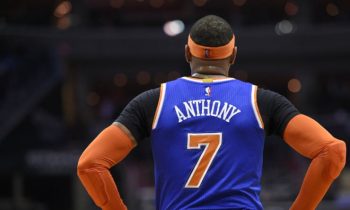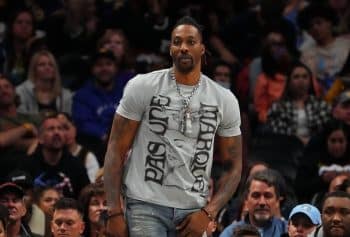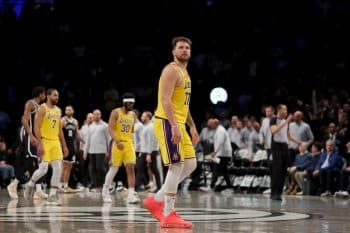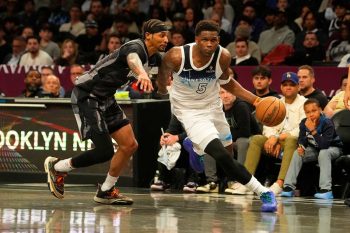NBA
2017 Free Agent Rankings: Point Guards
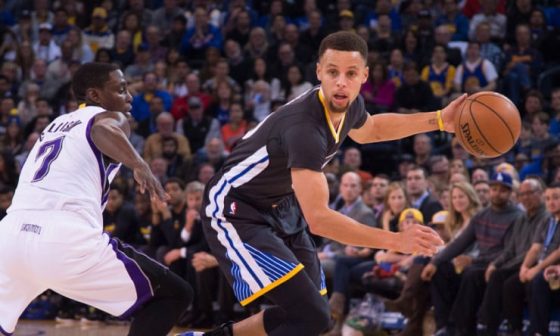
With the final weeks of the 2016-17 regular season upon us, the looming playoffs will have major implications for this summer’s impressive free agent class. While many observers expect the major stars to stay put, an early playoff exit could be the first domino to fall in a series of events that reshapes multiple NBA franchises. With so much at stake in the coming days, Basketball Insiders is getting an early jump on 2017 free agency, starting with today’s look at a deep point guard class.
A common theme throughout is that players, in most cases, will exert major leverage on the teams that will bid for their services. The available players are divided into four tiers, two for starters and two for the reserves.
Tier 1: Top Shelf Starters
1. Stephen Curry, Warriors
The Golden State Warriors, despite Kevin Durant’s injury and an off year from Stephen Curry — by his standards — are still the best team in basketball. And it is the two-time defending MVP who is leading the way, despite shooting a career-low from three-point range and his worst overall field goal percentage since 2012-13. After posting a 31.5 Player Efficiency Rating during last year’s back-to-back and unanimous MVP season, Curry is currently posting his lowest PER in four seasons (23.7).
Despite any struggles, the Warriors are performing better as a team with Curry on court than any other player. Golden State outscores opponents by 16.1 points per 100 possessions with Curry on court. That isn’t a team-high, but his off-court net is by a wide margin. The Warriors are 14.9 points per 100 possessions better with Curry on court than on the bench. Draymond Green is second in on/off net differential (+10.5), Klay Thompson is third (+9.8), and Durant fourth (+9.1). Even with Curry struggling from three-point range as he never has in his career, he makes the best team in the world better through his presence on the court.
As such, anything other than a super-max contract for Curry this summer is impossible to imagine. Durant also has a player option, but with Thompson and Green each signed for 2+ seasons at relative bargains, he’s likely to stay the course as well. That may mean departures for unrestricted free agents Andre Iguodala, Shaun Livingston and Zaza Pachulia, but that’s the price of having a Big Four.
2. Chris Paul, Clippers
Advanced stats actually favor Chris Paul over Curry. The Clippers’ floor general has a +18.4 on/off differential that leads the NBA. Paul is third among point guards in Box Plus-Minus per Basketball Reference and fourth in PER compared to a rank of fifth in both categories for Curry. This likely results from the additional burden on Paul due to a top-heavy roster that isn’t getting as much from its bench as the Warriors.
While the Clippers dominate with Paul on court, the team is 9.3 points per 100 worse with Austin Rivers on court compared to off, while Raymond Felton’s differential is a disastrous -12.8. Perhaps if Paul and Curry switched teams, Curry would struggle more while Paul led the Warriors to even greater heights. But in the real world, the tie goes to the player that produces in the standings, and ultimately in the playoffs. With the Clippers now only a game ahead of the seventh-place Grizzlies, Curry has a clear edge as the best point guard available in the coming offseason.
Barring health concerns, Paul will almost certainly exercise his early termination option to enter unrestricted free agency this summer. It’s a tricky situation for the Clippers as Blake Griffin has the same option while J.J. Redick is on an expiring contract. Luc Mbah a Moute — who has become an important piece — has a player option for $2.3 million he will almost certainly decline. DeAndre Jordan is the only player in the top five of the Clippers’ rotation who is under contract for next season with no options.
Is the Clippers’ late-season swoon a sign of fractured chemistry, or a consequence of lingering effects from the thumb injury Paul suffered earlier in the season? It’s hard to say, but an early playoff exit could ignite a chain reaction with one or more starters defecting in free agency. If Griffin leaves, there’s no telling where Paul could end up. And if the Clippers go deep into the luxury tax to sign Griffin and Paul to massive new contracts, would Redick — easily among the league’s best shooters — compromise his career earnings to stick around on a bargain contract? Anything less than a Western Conference Finals appearance could have disastrous consequences for L.A.
3. Kyle Lowry, Raptors
Among NBA point guards, only Kemba Walker, John Wall, Russell Westbrook, Curry and Paul have a better on/off differential than Kyle Lowry. His +10.1 trails only Patrick Patterson’s +10.9 for Toronto. With Terrence Ross departed to Orlando via the trade that brought back Serge Ibaka, Lucas Nogueira (+8.1) is currently the only other Raptor with a positive differential (minimum 300 minutes). The rest of the roster ranges from DeMarre Carroll’s -1.2 to Jakob Poeltl’s -8.8. The positive differentials for Patterson and Nogueira are almost certainly a consequence of spending the bulk of their minutes on court with Lowry (846 of 1328 minutes this season for Patterson, 734 of 1067 for Nogueira).
Lowry may not be in the same conversation with Curry and Paul, but these numbers show that he’s a difference maker that deserves to be on the highest tier of pending free agent point guards. One need look no further than the near-max contract the Magic gave Bismack Biyombo after his heroics in the playoffs to see the Lowry effect. A stout rebounder, defender and shot blocker, Biyombo has looked like a shell of himself this season without Lowry to set him up for attacks on the rim. Basketball Insiders editor and publisher Steve Kyler spoke to sources close to the Raptors during All-Star festivities in New Orleans, who said there is almost no scenario in which Toronto wouldn’t pay whatever it takes to keep Lowry, despite the wrist injury that has cost him extended time.
Simply put, the Raptors without Lowry are in danger of falling into the dreaded NBA purgatory. A healthy Toronto squad can compete for a second consecutive trip to the Eastern Conference Finals. If Lowry departs in the summer, the Raptors lack the cap space to replace him with anything close to equal talent. In that scenario, the Raptors would be too good to tank for high draft picks, but not good enough to contend. Toronto must do everything within its power to keep Lowry long term. Trading for Ibaka was almost certainly part of that equation.
4. George Hill, Jazz
The Jazz emerged as clear winners of the draft-day, three-team trade that brought George Hill from Indiana, sent Utah’s lottery pick (12, became Taurean Prince) to the Hawks and delivered Jeff Teague to his hometown Pacers. Hill has vastly outperformed Teague and newly-minted Hawks starting point guard Dennis Schroder this season, as evidenced by the Jazz’s current fourth seed in the brutal Western Conference. Hill’s +9.1 net differential ranks seventh among NBA point guards behind Lowry. He’s eighth in BPM and 14th in PER, placing him a step below Lowry but firmly in the upper echelon of free agent point guards.
Although Hill has only appeared in 43 games due to injury, he has emerged from Paul George’s shadow in Indiana and come into his own in Utah. It’s much easier now to see why San Antonio’s Gregg Popovich agonized over trading Hill for the pick the Spurs used to draft Kawhi Leonard. As with Lowry, the Jazz are left with no choice but to pay whatever the market demands to keep Hill. Trading a lottery pick made sense — even with Hill entering the season on an expiring contract — because Utah had plenty of young talent on the roster but lacked a frontline point guard. The Jazz’ situation was so dire last season that the team started Shelvin Mack in 27 games. That may be the fate that awaits Utah again if the organization can’t convince Hill to commit long-term. Any player that can elevate a lottery team to the brink of home-court advantage in the West deserves a spot this high on the list.
Tier 2: Serviceable Starters
5. Patty Mills, Spurs
While teams like the Warriors and Clippers are extremely top-heavy in terms of net rating differential, the Spurs are an anomaly. Patty Mills is nominally a bench player who leads San Antonio in net differential (+7.7) followed by fellow reserves David Lee (+4.7) and Manu Ginobili (+4.3). None of the trio has started more than 10 games this season. Meanwhile, the entire starting lineup is in the bottom six. This is likely due to Popovich starting Tony Parker and Pau Gasol, two players in the twilight of their career. Parker ranks no higher than 40th among NBA point guards in net differential, BPM and PER.
The upshot is that Mills may be a reserve for the second-best basketball team on Earth, but he could easily start for half the league’s teams. Mills will be paid as such this summer, and San Antonio shouldn’t think the rest of the league has failed to notice how good he is. Fortunately, the Spurs have LaMarcus Aldridge and Leonard signed through next season on reasonable contracts. Parker has one year left at $15.5 million and Gasol has a player option for $16 million, but the Spurs have full Bird rights for Mills. As such, San Antonio can spend into the luxury tax to keep Mills if that’s what is required. With the number of teams that will be after him, it almost certainly is. Mills’ piddling $3.6 million contract that expires at season’s end will have the old timers pining for the days when you could go to the movies for a nickel.
6. Jrue Holiday, Pelicans
Jrue Holiday is statistically very similar to Mills and Teague in terms of the stats used above. Mills obviously distinguishes himself by playing a major role on a true contender. But Holiday has another similarity to some of the point guards already discussed. Like Lowry and Hill, Holiday will have an unbelievable amount of leverage with his incumbent team when his final year at $11.3 million expires in a few short months.
Statistically, Holiday is around average for an NBA starter. Just don’t expect him to ask for an average salary July 1. If Holiday leaves New Orleans this summer, the Pelicans would only have as much as $15 million in cap space to find a replacement. That won’t get you any of the point guards listed above, nor some listed below. Teague will certainly be out of that price range after the Pacers gave up Hill to get him.
New Orleans’ best hope might be convincing Jrue’s older brother Justin Holiday, currently enjoying a breakout season with the Knicks, to join the team via an exception or cap space. The elder Holiday recently discussed his desire to play next season on the same team with his brother with Basketball Insiders senior writer Michael Scotto. The two may be a package deal for next season, which could work out well for a Pelicans team in desperate need of aid on the wing. Since New Orleans holds full Bird rights for Jrue, the team could potentially sign Justin with cap space then exceed the cap to sign his brother. This scenario becomes even more workable if Dante Cunningham declines his player option for $3.1 million to seek a longer-term deal.
7. Jeff Teague, Pacers
Theme warning: Market economics for NBA point guards will favor the supply side this summer, and that means suppliers of spin dribbles, assists and three-pointers like Jeffrey Demarco Teague. Back in 2013, then-Hawks GM Danny Ferry decided to play hardball with Teague, a restricted free agent. Rather than make an offer, the team waited for Teague to sign a dirt-cheap, four-year, $32 million offer sheet with the Milwaukee Bucks where he would have reunited with recently-departed Hawks coach Larry Drew. Ferry and newly-hired coach Mike Budenholzer likely made many a toast to their bargaining acumen.
But then, a few years later, Budenholzer learned the downside of such tactics. With the Hawks organization showing so little commitment to him, Teague apparently wasn’t too enthusiastic about spending the final year of his contract in Atlanta. Early last season, Teague put his condo in Buckhead on the market. Shortly after the Hawks were swept by the Cavaliers in the Conference Semifinals, Teague removed all Hawks-related images from his Instagram account. Teague then made and deleted a post on Instagram claiming that he played the entire 2015-16 season with a torn patellar tendon.
Perhaps it was the Hawks’ bargaining tactics, or perhaps it was fractured chemistry after his backup Schroder was quoted by German magazine Bild saying that he would seek greener pastures if he had not secured the starting job by the end of his current contract (Schroder insisted before a road game in Charlotte last season that he was misquoted and taken out of context by Bild). Whatever the reasons, Budenholzer made the decision to accelerate Schroder’s timeline by shipping Teague to the Pacers for the lottery pick Atlanta would use on promising small forward Taurean Prince. As mentioned, with Utah easily getting the best point guard out of the deal, Larry Bird’s back will be against the wall when it comes time to negotiate with Teague. There probably won’t be as many congratulatory slaps on the back as there were in Atlanta.
8. Darren Collison, Kings
Darren Collison has been a nomadic NBA starter who hasn’t won a lot. This is likely as much the fault of roster construction as Collison’s inability to elevate his teams. That could all change this summer after his contract expires with a final year at $5.2 million. One of those hard-bargaining point guards mentioned above could very well change teams, which would leave the incumbent team scrambling for an affordable replacement. Of all the players mentioned so far, Collison is the most likely — but by no means certain — to be available for a reasonable price. For example, if Holiday bolts from New Orleans, Collison could rejoin Cousins with the Pelicans and have the opportunity to play with a superstar in Anthony Davis. That has a much better ring to it than sticking around for an excruciating rebuild in Sacramento. Collison is at the lower end of starting NBA point guards, but he’s definitely a starter. He ranks in the 26-35 range in net differential, BPM and PER.
9. Derrick Rose, Knicks
Ranking Derrick Rose with the second tier probably counts as flattery. Rose will no doubt be seeking a max contract from his next super team, but the reality is that he’s 41st among NBA point guards in net differential and 48th in BPM. He’s somehow 21st in PER, a stat which is known to inflate the value of inefficient volume scorers. For the Knicks, Rose is right in the middle, neither elevating the team nor dragging it down from a net rating perspective. A bigger issue is probably Carmelo Anthony checking out on the organization with a -4.3 net differential that is worse than every Knick except Lance Thomas (-8). Rose has certainly been a workhorse, soaking up nearly 2000 minutes through 60 games, the third-highest total on the team.
Has Rose done enough to justify the kind of payday he doubtless believes he’s in line for after his deal expires July 1? With so many teams with their back against the wall, it only takes one. But if the Knicks double down on a failed personnel mix, it could be another wasted opportunity to begin building around Kristaps Porzingis.
Tier 3: Quality Reserves
10. Devin Harris, Mavericks
Devin Harris grades out better than Rose in the above-referenced metrics but he’s only played 867 minutes this season. Harris has battled injury issues throughout his career and been highly effective in stretches when injuries haven’t held him back. He’s a borderline starter when healthy but he’s getting toward the end of his career.
11. Yogi Ferrell, Mavericks
Talk about rubbing salt in the wounds. How painful must Yogi Farrell’s breakout for the Mavericks but for Brooklyn fans starving for talent? Sean Marks is a young, inexperienced GM, and this was a sharp lesson in the value of taking a longer look at guys before cutting them loose. It’s a sample of fewer than 800 minutes, but Ferrell has a very respectable +1.8 net differential that’s in the top half of the Mavericks’ roster. He’s also 30th among point guards in BPM and 38th in PER, giving him stats that verge on lower-end NBA starter. There’s a less than zero chance the Mavericks decline the team option to make Ferrell a free agent. He’s only mentioned here in the interest of piling on.
12. T.J. McConnell, 76ers
The Philadelphia 76ers are within a game of the Knicks and the metrics say T.J. McConnell is a better player than Derrick Rose. Shouldn’t he be ranked higher? It’s actually a fair question. McConnell has started 38 games this year with Sergio Rodriguez starting 30. The 76ers will likely target a point guard in the upcoming draft, which is rich with them. But the numbers say McConnell rates as a very competent reserve. Philly would be quite foolish not to guarantee his 2017-18 salary.
13. Ty Lawson, Kings
Although his stats can be dismissed as having been compiled on a bad team, Lawson ranks between 30th in PER and 40th in BPM. That indicates quite a bit of value for a reserve as long as you’re confident that Lawson has put his past off-court issues behind him. The one-year veteran’s minimum deal he signed with Sacramento may have served as a good rehab stop for him and a better situation could await in free agency.
14. Deron Williams, Cavaliers
The Mavericks were outscored by 2.6 points per 100 possessions in Deron Williams’ 1171 minutes on the court this season, so it was understandable for the team to take a shot on some younger talent. Nevertheless, he represents a significant upgrade at backup point guard for the Cavaliers, who had relied on Kay Felder previously. One of the more favorable stats for Williams is PER, where he ranks 28th among NBA point guards. As with Collison, he could be a viable Plan B for a number of teams if they miss out on their primary target in free agency.
15. Rajon Rondo, Bulls
It just hasn’t been all that the Bulls’ collection of veterans hoped at the beginning of the season. After Dwyane Wade and Jimmy Butler cracked down on the rookies, Rondo stood up for them. It wasn’t any one player’s fault, but the net result was fractured leadership and disunity. Only $3 million of next season’s $13.4 million is guaranteed, and there may be no front office less predictable than Chicago’s. Rondo could be sent on his way as a scapegoat for this season’s shortcomings, or he could be back with the Bulls providing quality minutes. Rondo is definitely in decline but there’s still something left in the tank.
Tier 4: The rest
Beno Udrih and Toney Douglas, two NBA nomads, along with Spencer Dinwiddie, are the closest players in this tier to making a move up. Brandon Jennings, like Rose, has some cache as a longtime starter, but the numbers in New York were brutal. Hopefully, he can have a good run with the Wizards and move up a tier ahead of this summer’s unrestricted free agency. Felton, as mentioned above with Paul, has also underperformed. Chicago’s Michael Carter-Williams, a pending restricted free agent, is statistically similar to Felton. The Bulls gave up a rotation player in Tony Snell to get him, so Chicago will almost certainly extend a qualifying offer in hopes that he will fulfill the promise he showed as Rookie of the Year. Rodriguez gave way to McConnell in Philly, and rightly so. He grades out worse than Felton.
Mack enjoyed a brief moment in the sun as the Jazz’ starter last season. His on/off numbers improved dramatically as opportunity and role often allow. But as soon as he went back to the bench, his efficiency numbers went back to their accustomed place south of the Felton Line. C.J. Watson, Ramon Sessions, Rodney Stuckey, Aaron Brooks, Brian Roberts, Jose Calderon, Shaun Livingston and Isaiah Canaan have all lived further south this season. Felder, Trey Burke and Semaj Christon have been at the farthest fringes among NBA point guards with enough minutes to draw any conclusions about.
